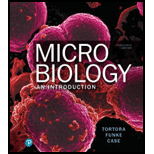
Concept explainers
The thermal death time for a suspension of Bacillus subtilis endospores is 30 minutes in dry heat and less than 10 minutes in an autoclave. Which type of heat is more effective? Why?
To review:
Which type of heat is more effective based on the thermal death time for a suspension of Bacillus subtilis endospores.
Introduction:
Bacillus subtilis is a rod-shaped, Gram-positive bacterium that are naturally found in soil and vegetation. B. subtilis grow in the mesophilic temperature range. The optimal temperature for the growth of this organism is 25ºC -35ºC.
Explanation of Solution
The cell wall is a rigid structure present outside the cell. Bacillus species are generally isolated by soil sprinkle technique and are used in the production of antibiotics. Ethanol, or strong acid or alkali are not effective in destroying the spores of B. subtilis. The use of chemicals generally does not kill the spores, and it only controls their growth and kills the living cells.
The effective way of destroying the endospores is by passing heat. Dry heat will take more time to penetrate through the cell. As moist heat easily penetrates through the cell, it is the effective way for the destruction of the endospores.
Based on the thermal death time (10 minutes) for B. subtilis endospores in an autoclave, moist heat is the effective method to kill B. subtilis endospores. In a sterilizing chamber, autoclave employs high temperature under pressure. It is used in the sterilization for surgical equipment and medical instruments. It is also used in pharmaceutical and food industries. The elevated temperature and pressure with steam creates an environment that is too high for any microorganisms or spores to live.
Moist heat penetrates into the bacterial cells easily and effectively kills vegetative bacteria as well as their spores. Compared to dry heat (thermal death time for B. subtilis endospores: 30 minutes), B. subtilis endospores are more effectively killed by an autoclave (moist heat).
Want to see more full solutions like this?
Chapter 7 Solutions
Microbiology: An Introduction Plus Mastering Microbiology with Pearson eText -- Access Card Package (13th Edition) (What's New in Microbiology)
Additional Science Textbook Solutions
Biological Science (6th Edition)
Genetics: From Genes to Genomes
Campbell Essential Biology (7th Edition)
HUMAN ANATOMY
Biology: Life on Earth with Physiology (11th Edition)
- Does it show the level of proteins? What about the amount? Levels of protein activation? How can you tell? Does the thickness tell you anything? What about the number of the lines? And the other questionsarrow_forwardKD 200- 116- 66- Vec ATF6 (670) ATF6 (402) ATF6 (373) ATF6 (366) I I 45- 1 2 3 4 5 ATFG (360) (e/c) 9V ATFG (402) g ant- ATF anti-KDEL DAPI barrow_forwardWestern blot results: what information can you get? Presence of proteins of your interest Levels of protein expression Levels of protein activation (must use activation state-specific antibody) Decreased function of the ATM kinase in aging mice. A C57BL/6 female 6 month Con IR 20 month C57BL/6 male 6 month 28 month Con IR Con IR Con IR p-ATM (S1981) ATM P-p53 (ser18) Actinarrow_forward
- Does it show the level of proteins? What about the amount? Levels of protein activation? How can you tell? Does the thickness tell you anything? What about the number of the lines?arrow_forwardWB: Protein of interest visualized by fluorescent Protein A Protein Barrow_forwardQuestion #4: Assume you are able to use CRISPR to create an allele that will convert a cross-pollinated, sexually reproducing crop plant into an obligate apomict. Your edited obligate apomict plants retains all the CRISPR "machinery" necessary to convert the "sexually reproducing" allele to the "obligate apomict" allele. You plant 100 hectares of your edited obligate apomicts in order to increase seed for sale the following year. Neighboring farms and seed producers are growing many different un-edited sexually reproducing varieties of the crop. If your neighbors plant seed harvested from their crops that was pollinated by your crop, should they expect these seeds to generate apomictic or non-apomictic plants? Type your answer here:arrow_forward
- calculate the questions showing the solution including variables,unit and equations all the questiosn below using the data.show solving and answer a) B1, b) B2, c) hybrid rate constant (1) d) hybrid rate constant (2) e) t1/2,dist t1/2,absorb f) t1/2,elim k) apparent central compartment volume (V1,app) p) total AUC (using short cut method) apparent volume of distribution based on AUC (VAUC,app) apparent clearance (CLapp) absolute bioavailabilty of oral route ( AUCiv =116ml)arrow_forwardPlease help me to draw this by hand. In as much detail as possible, hand draw a schematic diagram of the hypothalamic-pituitary-gonad (HPG) axis in the human female. Be sure to include all the relevant structures and hormones. You must define all abbreviations the first time you use them. Please include (and explain) the feedback loops.arrow_forwardPlease refer belowarrow_forward
- AaBbCc X AaBbCc individuals are crossed. What is the probability of their offspring having a genotype AABBCC?arrow_forwardcircle a nucleotide in the imagearrow_forward"One of the symmetry breaking events in mouse gastrulation requires the amplification of Nodal on the side of the embryo opposite to the Anterior Visceral Endoderm (AVE). Describe one way by which Nodal gets amplified in this region." My understanding of this is that there are a few ways nodal is amplified though I'm not sure if this is specifically occurs on the opposite side of the AVE. 1. pronodal cleaved by protease -> active nodal 2. Nodal -> BMP4 -> Wnt-> nodal 3. Nodal-> Nodal, Fox1 binding site 4. BMP4 on outside-> nodal Are all of these occuring opposite to AVE?arrow_forward
 Microbiology for Surgical Technologists (MindTap ...BiologyISBN:9781111306663Author:Margaret Rodriguez, Paul PricePublisher:Cengage LearningSurgical Tech For Surgical Tech Pos CareHealth & NutritionISBN:9781337648868Author:AssociationPublisher:Cengage
Microbiology for Surgical Technologists (MindTap ...BiologyISBN:9781111306663Author:Margaret Rodriguez, Paul PricePublisher:Cengage LearningSurgical Tech For Surgical Tech Pos CareHealth & NutritionISBN:9781337648868Author:AssociationPublisher:Cengage





